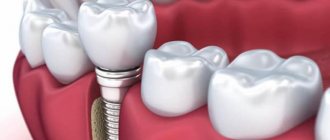Strong teeth have always been of great importance for human health. Any problems in this area created a lot of inconvenience, including for ancient people. Even they, as historical excavations show, tried to restore the integrity of the dentition with improvised means, using them as dentures. But the history of implantation began when the first attempts to “implant” artificial teeth into the jawbone appeared.
The very first cases of using dental implants
Several centuries BC, the Phoenicians tried to use similar implants, which were fixed with gold wire. Attempts to “grow in” new “teeth” have been used for many centuries, but were not successful, since the body rejected foreign objects.
However, about 1,500 years ago, the Aesculapians seem to have succeeded in introducing implants into the jawbone. An x-ray of the lower jaw, which belonged to a person of that time, showed the presence of implanted pieces of shells in the bone, overgrown with bone tissue. It is clear that in ancient times attempts to “implant” new teeth into the jaw were sporadic and not always successful. At that time there was no concept of the need for sterility. People also knew nothing about the properties of many materials. Therefore, those first attempts were rather just “harbingers” of a new method of tooth restoration.
Beginning of the scientific approach to dental implantation
At the end of the 19th century, for the first time, Russian doctor N. N. Znamensky gave a report on dental implantation at one of the congresses of doctors. The scientist drew the attention of the medical community to the fact that:
- the implant must be installed in the bone, and not in the socket of the extracted tooth;
- bone tissue must be properly processed and prepared for the introduction of an artificial root;
- the implant must be made of a material that is biocompatible with body tissues.
The results of the scientist’s research attracted attention, but the doctor did not have time to pass on his notes to his heirs. Therefore, there was a break in the history of implantation that lasted until the mid-20th century.
History of dental implantation
Home / Patients / This is interesting / History of dental implantationNovember 10, 2010 - Wednesday
The possibility of restoring lost teeth has interested people for thousands of years. This is confirmed by archaeological finds. Found, for example, on the territory of modern Honduras, a fragment of the lower jaw of an Inca (VI century BC), in which implants from the shell of sea mussels were preserved in place of the 42, 41 and 31 teeth. On the territory of Chantambray (France) the skull of a woman who lived in the 1st century was found. n. e., with a metal implant in the canine socket of the upper jaw.
The first attempts in the modern history of dental implantation
Some experts turned to the idea of dental implantation at the end of the 18th century. In 1809 Maggilio uses a gold implant. Despite the fact that even at that time the level of development of mechanics and engineering was quite significant, attempts at dental implantation were unsuccessful, because The concepts of asepsis and antiseptics were not yet known, and the processes of integration of dental implants into bone tissue were practically not studied. Because of this, implants were rejected and the idea of implantation had to be abandoned for more than 100 years; before Lister introduced the concept of “antiseptics,” the surgical wound almost always became infected and the implants were rejected “On the Antiseptic Principle of Surgical Practice” (1867)
The first fundamental research in the history of dental implantation
In 1888, Berry develops the principle of biocompatibility. In 1891, at the IV Pirogov Congress, and then in the journal “Medical Review”, a report by Privatdozent N.N. Znamensky "Implantation of artificial teeth." He pointed out that the best place for installing an implant is not the socket of an extracted tooth, but the restored bone, and the material for it should not react to physiological processes in the bone. The use of various biological materials for the manufacture of both implants and prostheses is beginning, the properties of inertness and tolerance are being studied, and metals are being actively introduced into clinical practice. The active development of the method as an independent and scientifically based direction in dentistry begins with the use of Vitallium cobalt-chrome alloy, which has high corrosion resistance to the electrochemical effects of tissue fluid, as an implantation material. The idea of dental implantation received new development in the 40s of the 20th century, when fundamental research was carried out in implantology, in particular, in the creation of implantation systems for use in maxillofacial surgery, traumatology, and dental prosthetics.
The beginning of a new era in the history of dental implantation
Per-Ingvar Branemark
Dental implantation in its modern form is due to the research of the Swedish scientist Per-Ingvar Branemark, who in 1952 discovered the phenomenon of osseointegration, which in 1977 was formulated by PI Branemark as “The direct structural and functional connection between highly differentiated living bone and the surface of the supporting implant, revealed on light microscope level. As often happens in the history of discoveries, the phenomenon of osseointegration by Brånemark was discovered in the course of research that was far from the use of dental implantation in dentistry, and indeed from implantology in general. Branemark studied post-traumatic processes in bone tissue and bone marrow, for which he introduced an optical camera, the body of which was made of titanium, into the bone tissue of experimental animals. Branemark decided to use titanium as the body of the optical camera. This metal was discovered in 1791, but its pure form was obtained more than 100 years later. Its commercial production required the development of new mechanical processing methods to achieve the surface structure that is perceived by living tissue. Titanium is highly resistant to chemical attack and is more resistant to corrosion than stainless steel. These properties made pure titanium an ideal metal for Branemark's experiments. In addition, this metal was recommended by orthopedic surgeon Hans Emnevs from Lund, who researched various metals used as hip prostheses. Brånemark received a sample of the metal made by Avesta Jernverk and began using pure titanium to make cameras. During the experiments, Brånemark discovered that the expensive camera could not be reused, because due to the bioinertness of titanium, the camera body was so firmly fused with the bone tissue that it actually became part of it. Bioinertness is defined as the complete absence of a rejection reaction on the part of the body - immune cells are simply not able to identify this metal as foreign and attack.
In 1952, the Swedish scientist P. Branemark formulated the necessary conditions for the success of dental prosthetics supported by implants - sterility, surface cleanliness, atraumaticity, geometric equality of the bed and the structure, which leads to a strong fusion of the metal surface with the bone, later called “osseointegration”.
In 1965, Professor Ingvar Brånemark led a group of researchers at the University of Gothenburg (Sweden) and proposed the use in dentistry of implants consisting of two parts - an intraosseous one and a support for the coronal part - an abutment - that is screwed to it.
Brånemark's first patient was Gosta Larsson, who had long-term dental problems, while visiting his dentist, accidentally heard about research being carried out at the University of Gothenburg and decided to volunteer for these early studies. He lost all his teeth in his lower jaw at the age of 34, had a cleft palate, a deformed upper jaw and chin, and experienced constant pain and significant difficulty eating and speaking. He had almost come to terms with these problems until he heard about a new study. 4 implants were installed on his lower jaw, after which dental prosthetics was performed, i.e., in fact, the first experience in dentistry with dental implantation actually became the first case of prosthetics on implants. After the treatment, Larsson could chew, eat and speak and lived a full life with this prosthesis until his death in 2006. The two-stage implantation technique proposed by Brånemark is successfully used to this day.
The time of active development of designs of implants of various shapes begins.
In 1963, based on the implants of A. Strock, R. Chercheve and S. Tramonte, the American scientist L. Linkow created a screw implant with a hole in the lower third of the intraosseous part, which improved its retention.
In 1965, P. Branemark proposed the use of a collapsible design of a screw implant, consisting of an intraosseous part and a support head (abutment) screwed to it. In 1969, L. Linkow invented another implant with an intraosseous part in the form of a plate, which made it possible to use it with narrow alveolar processes of the jaws.
In 1964, IA Small began to develop an implant, which was a plate with retention and transosseous pins for the atrophied lower jaw, and Dutch surgeons H. Bosker and L. VanDijk proposed a collapsible version of this design, calling it a transmandibular implant.
In 1970, H. Roberts proposed another implant design for an atrophied lower jaw, which is an arched plate designed for implementation in three places in the lower jaw.
In the 80s, a huge number of designs were proposed, most of which are modifications of the Branemark system implant. The design of P. Branemark two-stage screw implants has found wide application in practice.
However, the hostile attitude of the Swedish Dental Society towards Brånemark personally (Per Ingvar Brånemark was not a dentist by training) hampered the development of implantology. The personal and professional attacks directed against Brånemark forced him to study and implement the phenomenon of osseointegration with great caution.
When George Zarb, one of the most influential researchers in the development of artificial tooth root substitutes (University of Toronto, Canada), learned of Branemark's research, he immediately went to Gothenburg, where he spent six months convincing Branemark to share the results of his research with the world. Zarb and his group were the first to conduct research outside Sweden in parallel with Brånemark.
In order to accelerate the dissemination of the concept of osseointegration, a conference on osseointegration was held in 1982 in Toronto (Canada), on the basis of one of the dental clinics, with the support of the Universities of Toronto and Gothenburg. Zarb personally wrote an invitation to many famous researchers and scientists, inviting them to study a new and original technique for restoring teeth.
Most dentists attended the conference only because of Professor Zarb's invitation, and later noted that they did not expect the new technology to be better than all previous attempts.
Despite 15 years of clinical research, not only in Sweden, Brånemark was concerned whether the high dental society would accept his presentation; however, at the end of the conference, his research was highly appreciated, and over the following years, many participants at this conference even became his collaborators.
Since then, several world-renowned institutions have joined the team of developers and researchers of osseointegration in countries such as the United States, Canada, Australia, Belgium, Sweden, Spain, Italy, Brazil, Chile, Japan and Korea.
In the 90s, based on experimental studies, the possibility of osseointegration using one-stage screw implants was proven.
Zirconium implants
Recently, zirconium, which is an almost complete analogue of titanium in its physicochemical, mechanical and biological properties, has increasingly been used as a material for the manufacture of implants. The use of zirconium as a material for implants, abutments (a structure that replaces the supragingival part of the tooth) and restoration frameworks allows achieving better results in terms of aesthetics.
(based on Chapter 1 of the book “At the Origins - Brånemark and the Development of Osseointegration” - McClarence, Elaine - Quintessence Books, Berlin, Germany, 2003).
Implantology of new times
Dentistry owes the appearance of the first dental implants, similar to those currently used, to the Swedish scientist Ingvar Brånemark. The professor was researching the phenomenon of osseointegration, which he discovered in 1952. While conducting his experiments, Dr. Brånemark accidentally discovered the amazing properties of titanium - its bioinertness and ability to firmly fuse with bone tissue. Based on these and other data obtained by the Swedish scientist, the first titanium implants were developed, which were intended for fixing dentures.
In addition to Brånemark, other specialists also experimented with the properties of titanium. For example, orthopedic dentist L. Linkow installed his first titanium implant back in 1952 and successfully did so until 2002, so some experts consider him the founder of modern implantology.
First scientific research
At first, Brånemark did not intend to develop a procedure for implanting titanium components into bone, since his interest was directed towards studying the reproduction and behavior of blood cells in vivo. The thesis of the scientist's doctoral dissertation was based on a study of the blood supply to bone and bone marrow, since at that time there was not enough information regarding the reproduction of blood cells. Branemark wanted to study the regeneration of bone tissue, the interaction between bone, bone marrow and blood, and describe the processes occurring in the bone marrow after injury. To accomplish this task, he conducted a series of experiments in which he used a small optical camera surgically inserted into the tibia of a rabbit and examined the blood supply to the bone. This was the first step towards the discovery of the phenomenon of osseointegration.
Branemark decided to use titanium as the body of the optical camera. This metal was discovered in 1791, but its pure form was obtained more than 100 years later. Commercial production required the development of new machining methods to achieve a surface structure that would be perceived by living tissue. When it was discovered that titanium was highly resistant to chemical attack and corrosion, surpassing even flawless stainless steel, pure titanium became the ideal metal for Branemark's experiments. In addition, this metal was recommended by orthopedic surgeon Hans Emnevs from Lund, who researched various metals used as hip prostheses. Brånemark received a sample of the metal made by Avesta Jernverk and began using pure titanium to make cameras.
When inserting a titanium chamber into the rabbit's tibia, Brånemark followed the most gentle surgical procedure possible to cause minimal damage to the tissue. He believed that bone had a limited ability to heal and should be treated as carefully as other fragile tissues of the body, such as the eye or brain. After several months of experiments, Brånemark proved that bone regeneration is an interactive function of bone tissue and bone marrow. On the other hand, he sadly noted that the camera placed in the rabbit's tibia had become an integral part of the bone structure and could not be reused. Thus, the need for additional costs for further research became obvious.
Development of dental implantation today
A modern classic implant is made of titanium and has the shape of a cone or cylinder, with a mandatory thread. But implantology continues to develop. One of its promising directions is the use of zirconium dioxide for the production of artificial roots. This material is also durable, bioinert and close to titanium in some other properties. However, zirconium implants give dentists more options in terms of aesthetics of prosthetics.
The history of implantation today is not yet completed. Scientists in many countries continue to search for new production technologies and methods for installing dental implants. The goal is to improve the quality, comfort and effectiveness of treatment and extend the life of root substitutes.









